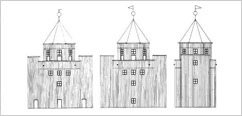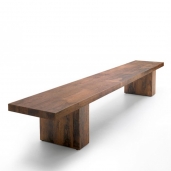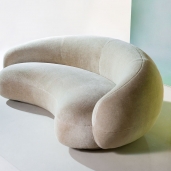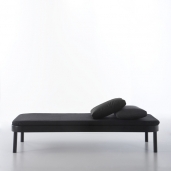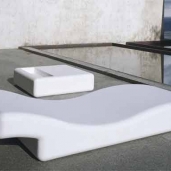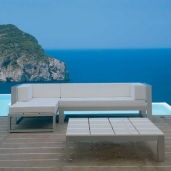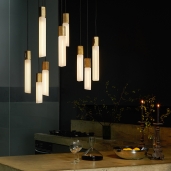Aldo Rossi
Italy
The late Aldo Rossi has achieved distinction as a theorist, an author, an artist, a teacher and as a architect, in his native Italy as well as internationally. Vincent Scully, in an introductory essay to a book on Rossi published by Rizzoli, compares him to LeCorbusier as a painter-architect. Ada Louise Huxtable, architectural critic and Pritzker juror has described Rossi as "a poet who happens to be an architect."
Rossi was born in Milan, Italy where his father was engaged in the manufacture of bicycles, bearing the family name, a business he says was founded by his grandfather. While growing up during the years of World War II, Rossi studied at the School of the Somaschi Fathers in Lake Como, and later at the Collegio Alessandro Votas in Lecco. Shortly after the war ended, he entered the Milan Polytechnic receiving his architecture degree in 1959.
Although early film aspirations were gradually transposed to architecture, he still retains strong interest in drama. In fact, he says, "In all of my architecture, I have always been fascinated by the theatre." For the Venice Biennale in 1979, he designed the Teatro del Mondo, a floating theatre, built under a joint commission from the theatre and architecture commissions of the Biennale. It seated 250 around a central stage. It was towed by sea to the Punta della Dogana where it remained through the Biennale. Rossi described the project in its site, as "a place where architecture ended and the world of the imagination began." More recently, he completed a major building for Genoa, the Carlo Felice Theatre which is the National Opera House.
In Canada, the first Rossi project in the Western Hemisphere was completed in 1987 when the Toronto Lighthouse Theatre was built on the banks of Lake Ontario.
In his book, A Scientific Autobiography, he describes an auto accident that occurred in 1971 as being a turning point in his life, ending his youth, and inspiring a project for the cemetery at Modena. It was while he was recuperating in a hospital that he began thinking of cities as great encampments of the living, and cemeteries as cities of the dead. Rossi's design for the cemetery at San Cataldo won first prize in a competition in 1971, and is being built in stages.
At almost the same time period, Rossi's first housing complex was being built on the outskirts of Milan. Called Gallaratese, the structure is actually two buildings separated by a narrow gap. Of Gallaratese, Rossi has said, "I believe it to be significant, above all, because of the simplicity of its construction, which allows it to be repeated." He has since built a number of solutions to housing, from individual homes to apartment buildings and hotels.
The Pocono Pines Houses in Pocono, Pennsylvania represent one of his first completed buildings in the United States. In Galveston, Texas,a monumental arch for the city has been completed. In Coral Gables, Florida, the University of Miami has commissioned Rossi to design the new School of Architecture.
Other housing projects include an apartment building in the Berlin-Tiergarten district of West Germany, and another called Sudliche Friedrichstadt. There have been numerous residence designs in Italy. His Il Palazzo Hotel and Restaurant Complex in Fukuoka, Japan is still another extension of his solutions for living quarters, completed in 1989.
Five important projects were completed in 1988: the Palazzo Regionale in Perugia (a civic center); a funerary chapel in Giussano built for the Molteni family; a town hall for Borgoricco; the Centro Torri Shopping Center in Parma; and in Turin, Casa Aurora, an office headquarters for GFT, parent company to the designer labels of Valentino, Emanuel Ungaro and Giorgio Armani.
These accomplishments in turn, gave clients in other countries the courage to call for Rossi's services as well, i.e., Canary Wharf Offices in London, an art gallery in Japan, a large residential quarters in The Hague, Netherlands, a restoration and addition to a monastery in Seville, Spain, and in his own country, a sports arena and many other projects. Also in 1989, Rossi won the competition in Germany over some 200 other entrants for the design of the Deutsches Historisches Museum in West Berlin. When Rossi was introduced at Harvard to deliver the Walter Gropius Lecture, the chairman of the architecture department, Jose Rafael Moneo said, "When future historians look for an explanation as to why the destructive tendencies that threatened our cities changed, Rossi's name will appear as one of those who helped to establish a wiser and more respectful attitude."
In the essay titled The End of the Century Finds a Poet, and quoted earlier, Vincent Scully calls Rossi "the incomparable Italian builder, the shaper of the most beautiful, almost entirely man-made country in the world."
The Pritzker Architecture Prize jury has once again recognized qualities in an architect that may have seemed, if not hidden, certainly not broadly proclaimed.
Designer Examples
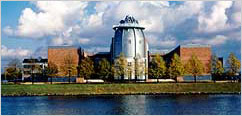
Bonnefanten Museum - Maastricht., Netherlands
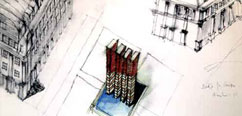
The Fountain - Original Scketch
